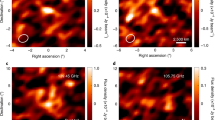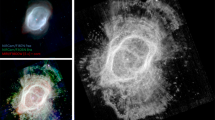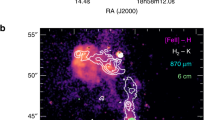Abstract
Current theory holds that jets, spirals and other detailed features in cometary comae are visible only in the continuum reflected by the dust particles. It has generally been thought that these features could not be seen in the emission bands of the typical neutral species, at least in part because the neutral parent molecules expand in directions perpendicular to any linear feature in a time short compared with that required to travel the length of the features. Consequently, the daughter species normally observable at optical and ultraviolet wavelengths are produced by dissociations that take place far from the point of origin of the gas. Here we present images of comet Halley taken in the light of CN emission, that show prominent jets extending to >60,000 km from the nucleus and lasting several weeks. We interpret these images as jets of submicrometre particles, perhaps the organic ‘CHON’ particles detected from spacecraft, from which the CN is directly produced.
This is a preview of subscription content, access via your institution
Access options
Subscribe to this journal
Receive 51 print issues and online access
$199.00 per year
only $3.90 per issue
Buy this article
- Purchase on Springer Link
- Instant access to full article PDF
Prices may be subject to local taxes which are calculated during checkout
Similar content being viewed by others
References
Sekanina, Z. & Larson, S. M. Astr. J. 92, 462–482 (1986).
Sekanina, Z. & Larson, S. M. Nature 321, 357–361 (1986).
Sekanina, Z. Adv. Space Res. 5, 307–316.
Krankowsky, D. et al. Nature 321, 326–329 (1986).
Vaisberg, O. L. et al. Nature 321, 274–276 (1986).
Bobrovnikov, N. T. Astrophys. J. 66, 145–169 (1927).
Bobrovnikov, N. T. Astrophys. J. 66, 439–464 (1927).
Wurm, K. & Mammano, A. Icarus 6, 281–291 (1967).
Mazets, S. P. et al. Nature 321, 276–278 (1986).
Simpson, J. A. et al. Nature 321, 278–280 (1986).
McDonnell, J. A. M. et al. Nature 321, 338–341 (1986).
Bockelee-Morvan, D. & Crovisier, J. Astr. Astrophys. 151, 90–100 (1985).
Kissell, J. et al. Nature 321, 280–282 (1986).
Kissell, J. et al. Nature 321, 336–337 (1986).
Levasseur-Regourd, A. C. et al. Nature 321, 341–344 (1986).
Moreels, G. et al. Nature 321, 271–273 (1986).
Greenberg, J. M. ESA-SP 249, 47–55 (1986).
Author information
Authors and Affiliations
Rights and permissions
About this article
Cite this article
A'Hearn, M., Hoban, S., Birch, P. et al. Cyanogen jets in comet Halley. Nature 324, 649–651 (1986). https://doi.org/10.1038/324649a0
Received:
Accepted:
Issue Date:
DOI: https://doi.org/10.1038/324649a0
This article is cited by
-
A rapid decrease in the rotation rate of comet 41P/Tuttle–Giacobini–Kresák
Nature (2018)
-
Constraints from Comets on the Formation and Volatile Acquisition of the Planets and Satellites
Space Science Reviews (2015)
-
Rotation of the Nucleus, Gas Kinematics and Emission Pattern of Comet 8P/Tuttle: Preliminary Results from Optical Imaging of the CN Coma
Earth, Moon, and Planets (2009)
-
Distributed Sources in Comets
Space Science Reviews (2008)
Comments
By submitting a comment you agree to abide by our Terms and Community Guidelines. If you find something abusive or that does not comply with our terms or guidelines please flag it as inappropriate.



